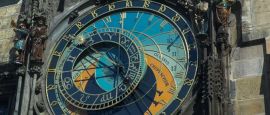Prague History
Prague's history goes back much further than its mediaeval skyline, beginning in the distant days of the Celtic Boii tribe who founded the city around 500BC. Unlike the Celts in the rest of Europe, it wasn’t the Romans who displaced the tribe in AD9 but the German Marcomanni.
The Marcomanni gave birth to the ruling Přemyslid dynasty, which remained pre-eminent in Prague until the 14th century. Among the Přemyslid rulers was Wenceslas (he of Christmas carol fame) who was killed by his brother Boleslav and now lies buried beneath St. Vitus’s Cathedral. Despite political convulsions, the era saw Prague grow in importance as a trading centre.
But for all the Přemyslid’s success, Prague’s real golden age commenced when Charles IV of Bohemia was elected Holy Roman Emperor in the mid-14th century. Flush with cash, Charles decided to overhaul the city and initiated an ambitious building programme, with St Vitus Cathedral and the Charles Bridge among the completed projects.
His feckless descendants, however, frittered Charles’ legacy away and when the last direct heir died childless, a Calvinist king called Frederick V of Pfalz was elected. His religion brought him into conflict with the powerful Hapsburgs, and Catholic armies rode out and defeated him in 1620, leaving Emperor Ferdinand II in charge. With political power now concentrated in Vienna, Prague began to decline.
After 400 relatively uneventful years of Hapsburg rule, the 20th century was traumatic for Prague: first, it was occupied by the Nazis and then yoked to the oppressive Soviet Union. The Russians, leaving Prague’s inhabitants cowed and despairing, ruthlessly crushed any dissent, most notably during the 1968 Prague Spring.
Although daunted, the Czech spirit remained undimmed, and when the Berlin Wall fell in 1989, the people took the opportunity to break away from Communism in what is now known as the Velvet Revolution. The Velvet Divorce followed as the Slovak portion of the old Czechoslovakia went its own way, leaving Prague the capital of the brand new Czech Republic.
Did you know?
• Prague was the first Eastern Bloc city to gain a Michelin-starred restaurant – the Allegro at the Four Seasons Hotel which is now closed.
• It was in Prague in 2006 that Pluto was downgraded from a planet to a dwarf planet.
• The grave of hard-line Communist president Antonín Novotný doesn’t have his name on it – the only sign of his presence is a carved signature.
Do you have any Feedback about this page?
© 2026 Columbus Travel Media Ltd. All rights reserved. No part of this site may be reproduced without our written permission, click here for information on Columbus Content Solutions.




 You know where
You know where